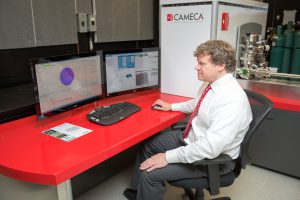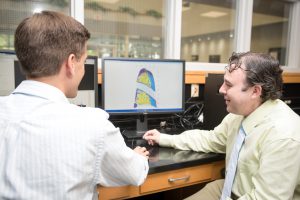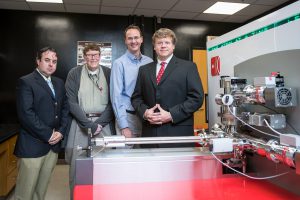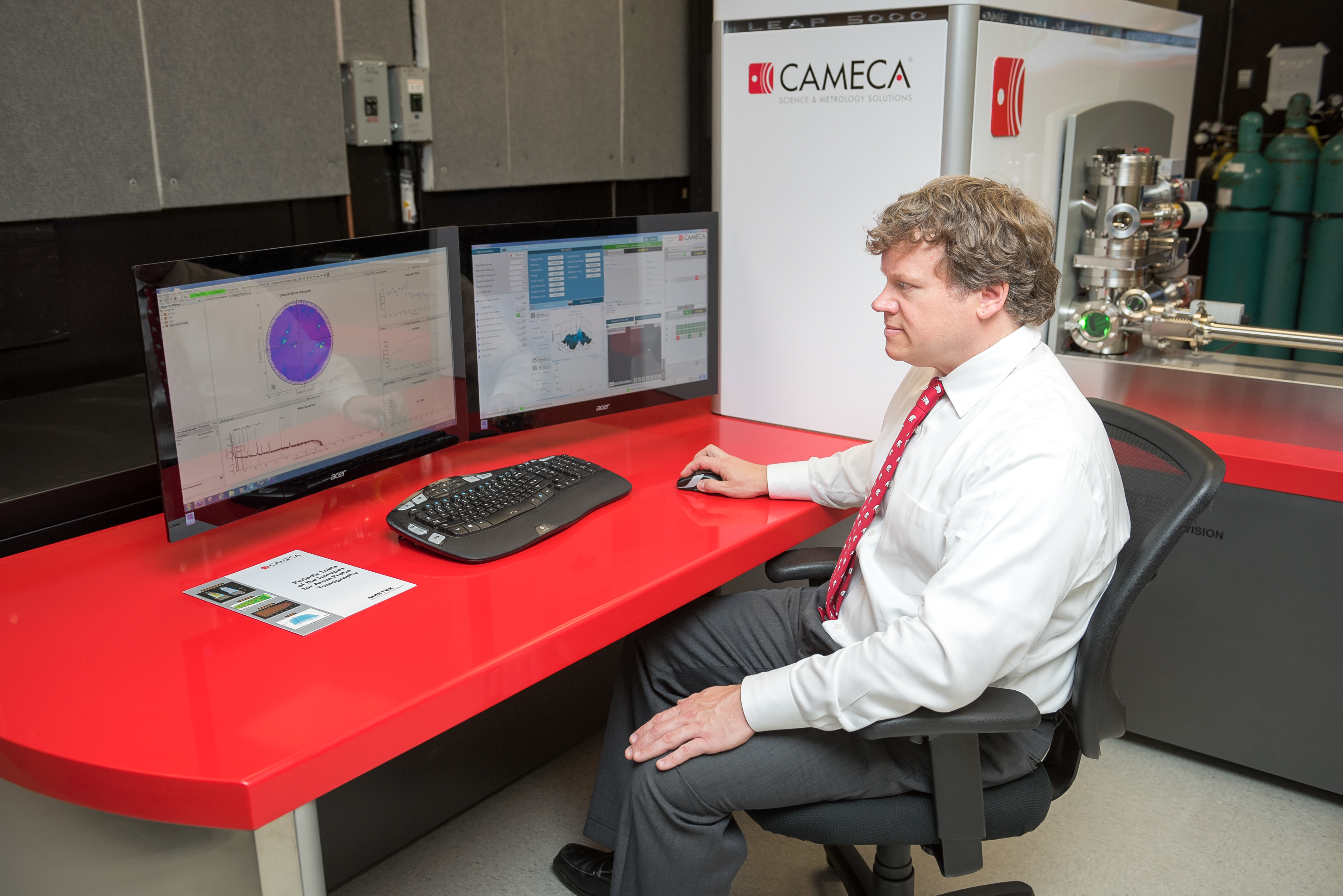
TUSCALOOSA, Ala. – A new, powerful microscope recently installed at The University of Alabama will expand exploration into nanotechnology and geological sciences, helping research and spurring economic development.
Earlier this year, UA acquired the newest generation Local Electron Atom Probe, or LEAP. This microscope shows researchers the location and distribution of atoms in materials. Unlike the previous LEAP at UA, the new instrument, the CAMECA LEAP 5000, provides tremendous versatility that reveals a more detailed atomic map of a material with the ability to probe such geological materials as fossils and minerals.
“UA is the first academic institution in the Western Hemisphere to acquire a LEAP 5000, and it keeps UA at the leading edge of nanoscience and nanotechnology,” said Dr. Carl A. Pinkert, vice president for research and economic development. “Elevating our research capabilities with a new instrument will open up international collaborations for our faculty and give our students greater opportunities to work with advanced technology.”
The LEAP 5000 is set up in UA’s Central Analytical Facility, a research lab dedicated to nanoscale characterization — studying and manipulating materials that can be 1,000 times smaller than a human hair.
“The LEAP 5000 places us at the forefront of materials analysis,” said Dr. David Nikles, director of the Central Analytical Facility and chemistry professor. “This improved capability will expand the ability of UA research groups to characterize many new and different classes of materials.”
The LEAP’s introduction to science in 2003 provided a renaissance in the atom probe field by allowing millions of atoms to be collected in minutes, rather than weeks as done with older generation microscopes.
In 2007, UA bought a LEAP 3000 to become the first academic institution in the Southeast — and only the third in the nation — to have the instrument on campus. Since installation, the instrument generated more than $13 million in externally sponsored research.
“Being a leader in atom probe research not only helps further scientific understand, but our students and faculty help provide solutions for our industry partners, which adds economic value to this state and region,” Pinkert said.

In addition to users from campus and other universities, the LEAP has been used by researchers in several industries, including automotive, computing and aerospace, along with federal agencies including NASA and the Department of Defense. Also, the atom probe and the research experiences it brought UA professors led to UA hosting the International Field Emission Symposium in 2012, the premier international atom probe and nanosciences conference that brought in more than 170 participants from 15 countries.
“The LEAP 3000 helped place the Central Analytical Facility and The University of Alabama on the map as a multi-user facility for nanoscale characterization of materials,” Nikles said. “It attracted users from universities and public-private partnerships across the country.”
Students who were trained on the instrument have gone on to work in advanced manufacturing industries with such companies as Intel, Boeing, and Seagate,said Rich Martens, manager of the Central Analytical Facility.
The new LEAP 5000 allows UA and affiliated researchers to study newer materials the older microscope could not handle without destroying them. In particular, several geological materials can be studied for the first time including fossilized bones and other organic structures as well as semi-conducting materials, Nikles said. The device could lead to expansion of research opportunities to such industries as medicine, mining and energy.
The main difference is that the new atom probe uses an ultraviolet laser with a lower energy setting, allowing more brittle materials to withstand the field evaporation process, which removes atoms from the surface, Martens said.
Already, the new atom probe is attracting attention from researchers outside the fields of material science and metallurgical engineering. With sponsorship from the National Science Foundation, Dr. Alberto Perez-Huerta, an associate professor of geological sciences at UA, hosted the first atom probe tomography workshop for earth sciences on campus earlier this year, attracting colleagues from across the world.

Geologists and chemist have long been able to see the amount of certain elements in a material by chemical decomposition, but those methods do not give a 3D map at the atomic level like the atom probe, Perez-Huerta said.
The LEAP 5000 makes it possible to look for trace elements in minerals, helping to see the composition of the material in three dimensions and how it formed. This ability can lead to better understanding of how to use economically valuable deposits, Perez-Huerta said. Also, biominerals — minerals formed organically — can be studied in much better ways to help develop the next-generation of bio-materials, he said.
Applications could range from enhancing drug delivery to better dental care after studying cavities to using organic fibers to strengthen materials, he said.
“With the LEAP 5000, the University is at the forefront of this technology,” Perez-Huerta said.
Besides newer materials, the instrument can also capture 50 percent more atoms than the older tool, helping characterize the tiniest changes in atomic layout in a material, which could have a tremendous impact on mechanical and electrical properties, said Dr. Gregory Thompson, professor of metallurgical engineering and associate director of the Central Analytical Facility.
“The strategic acquisition of the LEAP 5000 positions UA researchers to maintain their leadership in atomic scale characterization of materials across multiple disciplines, become more competitive in winning research grants, and in attracting talented, new faculty to UA because of the distinct capabilities available on our campus,” Thompson said.
Contact
Adam Jones, UA media relations, 205/348-6444, acjones12@eng.ua.edu
